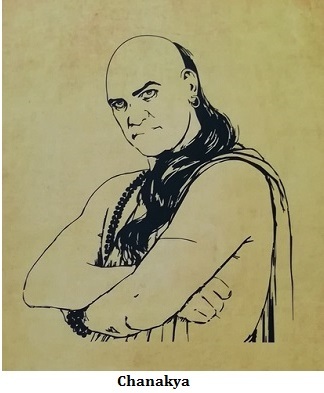

 Arthashastra is a Sanskrit word “Artha” which means “Aim”, and “Shastra” means “book”, so it is “The science of Politics”, or “Science of Material Gain”.
Arthashastra is a Sanskrit word “Artha” which means “Aim”, and “Shastra” means “book”, so it is “The science of Politics”, or “Science of Material Gain”.
It was written by Chanakya or Kautilya the Prime minister in the Maurya empire Chandragupta. Chandragupta was the founder of the Maurya Empire. “Arthashastra” is a manuscript about how to rein a kingdom and action taken regarding political concerns.
Hinduism and the Philosophical School of Charvaka explained the “Arthashastra. The Charvaka explained the political approach to life which is based on logic, action regarding events and objective based. While Arthashastra is subjective based, on how a ruler should take action.
The manuscript takes reference from a text written by Sanskrit intellect “Rudrapatna Shamasatry” who published and translated it into English in 1909 and 1915 respectively. It was compared to The Italian book “The Prince” written by Philosopher Niccolò Machiavelli. But Arthashastra was written in 1500 earlier than “The Prince”.
During the fourth century BCE,the Vishnugupta (Chanakya)wrote the Arthashastra- the science of wealth, and welfare before 1500. It has 150 chapters, which are written in 15 different books. It was written in Ancient India. Furthermore, it has three parts;
“Arthaniti” (Economic Politics)
“Dandaniti”(Administration of Justice)
“Videshnitit” (Foreign Affair Policy.)
Various philosophers transcribe the “Arthashastra” of Chanakya in a different manifestation.
G.P. Singh transcribed Arthashastra into “Science of Polity”.
“R. Shamastry 1915” transcribed Arthastra into 15 books. These are;
“Concerning Discipline”
“The Duties of Government Superintendents”.
“Concerning Law”.
“The Removal of Thorns”.
“The conduct of Courtiers”.
“The source of Sovereign States”.
“The End of the six-fold policy”.
“Concerning Vices and Calamities”.
“The Work of an Invader”.
“Relating to War”.
“The conduct of the Corporation”.
“Concerning a powerful Enemy”.
“Strategies Mean to capture a fortress”.
“Secret Means”
“The Plan of a Treatise”.
Patrick Olivelle Transcribes it into The Arthashastra Selection from the Classic “Indian Work on statecraft”.
The Arthashastra is split into “15 Adhikarnas” that consist of “150 divisions”, “180 topics” and 6000 verses. All fifteen books are further divided into various chapters. The First book consists of “21 chapters”. The second book consists of “36 chapters”.
The Arthashastra contains the science of Artha means i.e. Material Prosperity, which is one of the aims of human life. Chanakya infers “Artha” sustenance of humanity i.e. wealth and earth are the two main concerns.
In his book, he focused to express his concern about monarchy and focused on kinship.
He said that in a political organisation, there should be 7 elements.The King, ministers, land, fortress, army, ally, and wealth.
King, is the one who serves his clan
Ministers; who be in service to King
Land for resources,
Fortress for protection and control
Wealth for expansion and maintenance.
Army for defence
Ally to achieve goals.
The three main strength of a king is good counsel, dignity of king, and strength to stimulate.
The king should not abstain from Dharma, and he should be the administrator of Dharma.
King should be free from anger, materialism, sex, self-love, fervour, and ecstasy.
The contentment of the king should lie in his people’s contentment.
Correlation between other empires should be based on six types of approach; Treaty (Sandhi), Unbiased (Asana), Conflict (Vigraha), clash against the enemy (yana), defence against the king (samshraya), dual strategies (dvaidhibhava).
The implementation of policy is based on truth and vows are based on spiritual outcomes.
“Artha is the Sustenance”, or “Livelihood of men”, “Science of Politics” and “Arthashastra” are some translations by R.P. Kangle.
“Science of Material Gain” is translated by D.D. Kosambi.
“Science of Politics” is by Patric Olivelle.
The most undeviating composition of Arthashastra is “The Philosophical School of Charvaka” composed in 600 BCE.
The policies framed by Chanakya governance, quality, politics, and progress are linked to the well-being of the people. The terminology mentioned in the Arthashastra might be changed in respect of the current scenario, but the intention remains the same. He explained the taxation, foreign trade, accountability of kings towards his people, and liabilities of people towards the king. The various policies and aspects of Chanakya towards administration remains landmark from generation to generation.
The Arthashastra is a classic compendium of administration and foreign affairs and is relevant to the current scenario. Prime shades of Chanakya’s policy are non-alignment and no first war policy. It's a reference book for 21st-century and future policies.
Major administrative development held in India was during the Maurya period. At that time the empire was divided into provinces and provinces into districts and districts into rural and urban centres. It is all mentioned in the Arthashastra translation by R. Shamastry published in 1909 AD. Arthashastra is the treasure of functions like bureaucracy, management, administration, and political and social norms.
Q1. What is mentioned taxation in Arthashastra?
Ans. Chanakya has mentioned indirect taxes like custom duties, excise, and direct taxes as income taxes. He noted that the king's wish should not be public revenue, but the economic position of the state should be public revenue.
Q2. How many types of warfare are mentioned in Arthashastra?
Ans. Chanakya has defined three types of warfare in which the king must engage,
Open War: involvement in the war by the military.
Covert War: involvement via political trickeries.
Silent War: Economic and personal attacks are mentioned and spying, and murders are involved.
Q3. In how many varna divided jobs of people in Arthashastra?
Ans. People should work according to their varnas,
Brahmana: They work as priests, intellectuals, and teachers of the highest caste.
Kshatriya: Kastriya work as warriors, protectors, and guardians of the King.
Vaishya: They work as merchants, farmers, and clerks.
Shudra: They are of the lowest caste and work as labour, and servants.